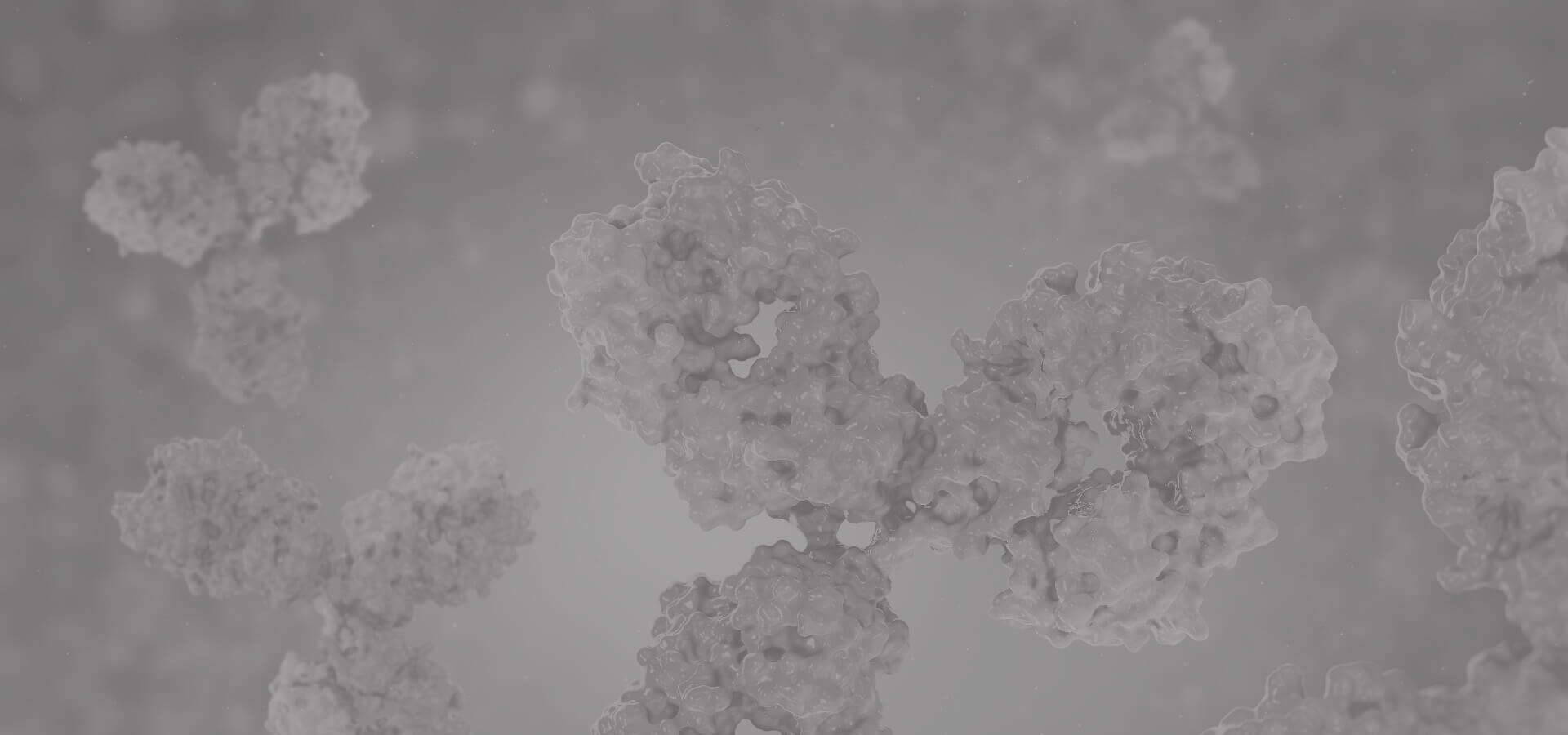DNMT3A Antibodies
Background
DNMT3A gene encoding a key DNA methyltransferase, primarily from methylating enzyme in early vertebrate development and play a role in the process of cell differentiation. This enzyme regulates gene expression and maintains genomic stability by catalyzing the addition of methyl groups to cytosine on CpG islands, which is crucial for embryo formation and hematopoietic function. In mammals, functional abnormalities of DNMT3A are closely related to hematological malignancies such as acute myeloid leukemia, and its mutations can lead to methylation pattern disorders. This gene was first identified in 1998. The analysis of its three-dimensional structure provided an important foundation for the study of epigenetic regulatory mechanisms and significantly promoted people's understanding of DNA methylation, epigenetic disorders and treatment strategies for related diseases.
Structure of DNMT3A
DNMT3A is a key DNA methyltransferase with a molecular weight of approximately 100 kDa. The specific value varies slightly among different species due to minor differences in amino acid sequences.
| Species | Human | Mouse | Rat |
| Molecular Weight (kDa) | ~100 | ~101 | ~100 |
| Primary Structural Differences | Contains PWWP, ADD and catalytic domains | Highly conserved structure of catalytic domain | The ADD domain has an extremely high homology with humans |
This enzyme is composed of 912 amino acids, and its primary structure folds to form multiple functional domains. The core of DNMT3A is its catalytic domain, which contains a conserved PCQ motif responsible for binding to S-adenosylmethionine (SAM) and providing a methyl group. Its PWWP domain is responsible for recognizing histone markers and targeting specific genomic regions, while the ADD domain senses histone modification states and regulates enzyme activity. These domains collaborate with each other to ensure that DNMT3A can accurately perform de novo DNA methylation on the genome, thereby precisely regulating gene expression.
 Fig. 1 Strategies for targeting DNMT3A mutant AML. 1
Fig. 1 Strategies for targeting DNMT3A mutant AML. 1
Key structural properties of DNMT3A:
- Contains the typical methyltransferase folding domain
- The catalytic center forms highly conserved PCQ motifs
- Histone modifications are identified through the PWWP domain
- The ADD domain is responsible for sensing the chromatin state
- Zinc finger structure maintains the three-dimensional conformation of proteins
- Dimerization interfaces mediate protein oligomerization
Functions of DNMT3A
The core function of the DNMT3A gene is to perform de novo DNA methylation on the genome and establish and maintain DNA methylation patterns. In addition, it is also involved in a variety of key biological processes, including gene imprinting, X chromosome inactivation and maintaining genomic stability.
| Function | Description |
| De novo methylation | During embryonic development and early cell differentiation, it catalyzes the addition of methyl groups to cytosines on CpG dinucleotides to establish new methylation patterns. |
| Transcriptional regulation | By promoting methylation in the promoter region of genes and silencing the expression of specific genes (such as tumor suppressor genes), cell fate is regulated. |
| Genomic stability | Maintain the methylation pattern of the genome, inhibit the activity of transposon elements and heterochromatin formation, and protect chromosomal integrity. |
| Regulation of cell differentiation | In adult stem cells such as hematopoietic stem cells, the direction of cell differentiation is determined by methylation patterns, and their functional disorders are closely related to blood diseases. |
| Cooperative regulation function | Synergistic effect with DNMT3L and other cofactors to enhance catalytic efficiency; And it interacts with histone modifications to form an epigenetic regulatory network. |
Unlike the maintenance function of constitutive methyltransferase DNMT1, the activity of DNMT3A does not depend on DNA replication. The establishment of its methylation pattern is temporal and site-specific, indicating its key role as an epigenetic "writer". Its dysfunction is a hallmark feature of diseases such as acute myeloid leukemia (AML).
Applications of DNMT3A and DNMT3A Antibody in Literature
1. Yang, Xuejiao, et al. "DNMT3A mutation promotes leukemia development through NAM-NAD metabolic reprogramming." Journal of Translational Medicine 21.1 (2023): 481. https://doi.org/10.1186/s12967-023-04323-z
This study indicates that the DNMT3A R882H mutation upregulates NAMPT expression through hypomethylation, leading to abnormal nicotinamide metabolism and increased NAD synthesis, thereby promoting cell cycle progression and malignant progression of AML. Inhibiting NAMPT can delay the development of leukemia.
2. Man, axia, et al. "DNMT3A and DNMT3B in breast tumorigenesis and potential therapy." Frontiers in Cell and Developmental Biology 10 (2022): 916725. https://doi.org/10.3389/fcell.2022.916725
This review focuses on DNMT3A and DNMT3B, exploring their roles in the occurrence and development of breast cancer, SNP mutations, non-coding RNA and signaling pathway regulation, and pointing out that targeting them may be potential therapeutic strategies.
3. Huang, Guiqin, aoya Cai, and Dengju Li. "Significance of targeting DNMT3A mutations in AML." Annals of Hematology 104.3 (2025): 1399-1414. https://doi.org/10.1007/s00277-024-05885-8
The article indicates that DNMT3A is the most common mutant gene in AML, mostly seen in elderly patients, and it affects the progression and prognosis of leukemia through epigenetic regulation. This article reviews its functions, the impact of mutations on AML, and potential targeted therapeutic strategies.
4. Zhu, Liyuan, et al. "RNautophagic regulation of DNMT3a‐dependent DNA methylation by Linc00942 enhances chemoresistance in gastric cancer." Clinical and Translational Medicine 13.7 (2023): e1337. https://doi.org/10.1002/ctm2.1337
The article indicates that starvation degrades Linc00942 by activating autophagy, inhibits its mediated m6A modification, thereby reducing the expression of DNMT3A and the level of genome-wide methylation, and reversing tumor chemotherapy resistance.
5. Jiang, Menglong, et al. "DNMT3a promotes LUAD cell proliferation and metastasis by activating the HDAC7 signalling pathway." International Journal of Biological Sciences 21.4 (2025): 1585. https://www.ijbs.com/v21p1585.htm
The article indicates that DNMT3A is highly expressed in lung adenocarcinoma. It promotes the expression of ZEB1 and c-Myc by up-regulating HDAC7, accelerating tumor proliferation and metastasis. Patients with co-low expression of DNMT3A/HDAC7 have the best prognosis, suggesting that dual-targeted intervention has therapeutic potential.
Creative Biolabs: DNMT3A Antibodies for Research
Creative Biolabs specializes in the production of high-quality DNMT3A antibodies for research and industrial applications. Our portfolio includes monoclonal antibodies tailored for ELISA, Flow Cytometry, Western blot, immunohistochemistry, and other diagnostic methodologies.
- Custom DNMT3A Antibody Development: Tailor-made solutions to meet specific research requirements.
- Bulk Production: Large-scale antibody manufacturing for industry partners.
- Technical Support: Expert consultation for protocol optimization and troubleshooting.
- Aliquoting Services: Conveniently sized aliquots for long-term storage and consistent experimental outcomes.
For more details on our DNMT3A antibodies, custom preparations, or technical support, contact us at email.
Reference
- Huang, Guiqin, aoya Cai, and Dengju Li. "Significance of targeting DNMT3A mutations in AML." Annals of Hematology 104.3 (2025): 1399-1414. https://doi.org/10.1007/s00277-024-05885-8
Anti-DNMT3A antibodies
 Loading...
Loading...
Hot products 
-
Mouse Anti-ADV Recombinant Antibody (V2-503423) (CBMAB-V208-1364-FY)

-
Mouse Anti-AKT1 (Phosphorylated S473) Recombinant Antibody (V2-505430) (PTM-CBMAB-0067LY)

-
Mouse Anti-CIITA Recombinant Antibody (CBLC160-LY) (CBMAB-C10987-LY)

-
Mouse Anti-CD1C Recombinant Antibody (L161) (CBMAB-C2173-CQ)

-
Mouse Anti-dsRNA Recombinant Antibody (2) (CBMAB-D1807-YC)

-
Mouse Anti-BANF1 Recombinant Antibody (3F10-4G12) (CBMAB-A0707-LY)

-
Rabbit Anti-AP2M1 (Phosphorylated T156) Recombinant Antibody (D4F3) (PTM-CBMAB-0610LY)

-
Mouse Anti-BPGM Recombinant Antibody (CBYY-1806) (CBMAB-2155-YY)

-
Mouse Anti-CRYAB Recombinant Antibody (A4345) (CBMAB-A4345-YC)

-
Rabbit Anti-Acetyl-Histone H3 (Lys36) Recombinant Antibody (V2-623395) (CBMAB-CP0994-LY)

-
Mouse Anti-ARSA Recombinant Antibody (CBYC-A799) (CBMAB-A3679-YC)

-
Rabbit Anti-ALDOA Recombinant Antibody (D73H4) (CBMAB-A2314-YC)

-
Rabbit Anti-ALOX5AP Recombinant Antibody (CBXF-1219) (CBMAB-F0750-CQ)

-
Mouse Anti-Acetyl-α-Tubulin (Lys40) Recombinant Antibody (V2-623485) (CBMAB-CP2897-LY)

-
Mouse Anti-AQP2 Recombinant Antibody (E-2) (CBMAB-A3358-YC)

-
Mouse Anti-CRTAM Recombinant Antibody (CBFYC-2235) (CBMAB-C2305-FY)

-
Mouse Anti-CCNH Recombinant Antibody (CBFYC-1054) (CBMAB-C1111-FY)

-
Mouse Anti-ALB Recombinant Antibody (V2-55272) (CBMAB-H0819-FY)

-
Rabbit Anti-AKT2 (Phosphorylated S474) Recombinant Antibody (V2-556130) (PTM-CBMAB-0605LY)

-
Mouse Anti-CCN2 Recombinant Antibody (CBFYC-2383) (CBMAB-C2456-FY)

- AActivation
- AGAgonist
- APApoptosis
- BBlocking
- BABioassay
- BIBioimaging
- CImmunohistochemistry-Frozen Sections
- CIChromatin Immunoprecipitation
- CTCytotoxicity
- CSCostimulation
- DDepletion
- DBDot Blot
- EELISA
- ECELISA(Cap)
- EDELISA(Det)
- ESELISpot
- EMElectron Microscopy
- FFlow Cytometry
- FNFunction Assay
- GSGel Supershift
- IInhibition
- IAEnzyme Immunoassay
- ICImmunocytochemistry
- IDImmunodiffusion
- IEImmunoelectrophoresis
- IFImmunofluorescence
- IGImmunochromatography
- IHImmunohistochemistry
- IMImmunomicroscopy
- IOImmunoassay
- IPImmunoprecipitation
- ISIntracellular Staining for Flow Cytometry
- LALuminex Assay
- LFLateral Flow Immunoassay
- MMicroarray
- MCMass Cytometry/CyTOF
- MDMeDIP
- MSElectrophoretic Mobility Shift Assay
- NNeutralization
- PImmunohistologyp-Paraffin Sections
- PAPeptide Array
- PEPeptide ELISA
- PLProximity Ligation Assay
- RRadioimmunoassay
- SStimulation
- SESandwich ELISA
- SHIn situ hybridization
- TCTissue Culture
- WBWestern Blot








